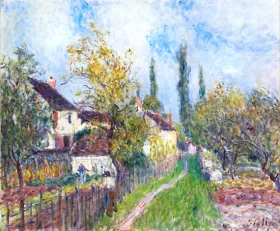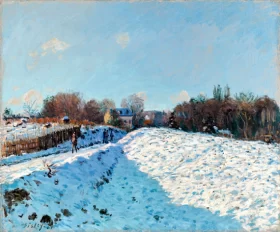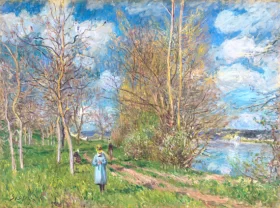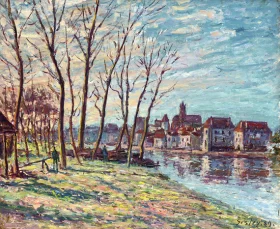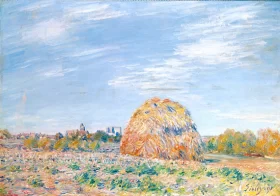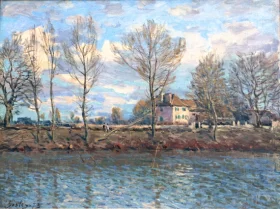5% Off Sitewide | Use code KMUS5 on checkout
- Choose your Country
5% Off Sitewide | Use code KMUS5 on checkout
Alfred Sisley
Alfred Sisley (30 October 1839 – 29 January 1899) painter who was one of the creators of French Impressionism, who was born and spent most of his life in France, but retained British citizenship. He was the most consistent of the Impressionists in his dedication to painting landscape en plein air (i.e., outdoors). He deviated into figure painting only rarely and, unlike Pierre Auguste Renoir and Camille Pissarro, found that Impressionism fulfilled his artistic needs.
Sisley was born in Paris to affluent British parents. His father, William Sisley, was in the silk business, and his mother, Felicia Sell, was a cultivated music connoisseur. In 1857, at the age of 18, Alfred Sisley was sent to London to study for a career in business, but he abandoned it after four years and returned to Paris in 1861. Sisley began painting as an amateur, from 1862, he studied at the Paris École des Beaux-Arts within the atelier of Swiss artist Marc-Charles-Gabriel Gleyre where he began his association with Claude Monet, Pierre Auguste Renoir, and Jean-Frédéric Bazille. Together they would paint landscapes en plein air rather than in the studio, in order to capture the transient effects of sunlight realistically. This approach, innovative at the time, resulted in paintings more colourful and more broadly painted than the public was accustomed to seeing.
In 1866, Sisley began a relationship with Eugénie Lescouezec (1834–1898; usually known as Marie Lescouezec), a Breton living in Paris. The couple had two children: son Pierre (born 1867) and daughter Jeanne (1869). At the time, Sisley lived not far from Avenue de Clichy and the Café Guerbois, the gathering-place of many Parisian painters.
In 1868, his paintings were accepted at the Salon, but the exhibition did not bring him financial or critical success; nor did subsequent exhibitions.
The Franco-German War of 1870–71 brought financial ruin to the Sisley family and caused Sisley to flee temporarily to London. At this period of crisis he decided to make painting his full-time career. The rest of his life was a constant struggle against poverty, as his paintings did not rise significantly in monetary value until after his death. Occasionally, however, Sisley would be backed by patrons, and this allowed him, among other things, to make a few brief trips to Britain. The first of these occurred in 1874, after the first independent Impressionist exhibition. The result of a few months spent near London was a series of nearly twenty paintings of the Upper Thames near Molesey, which was later described by art historian Kenneth Clark as “a perfect moment of Impressionism.”
Until 1880, Sisley lived and worked in the country west of Paris; then he and his family moved to a small village near Moret-sur-Loing, close to the forest of Fontainebleau, where the painters of the Barbizon school had worked earlier in the century. Here, as art historian Anne Poulet has said, “the gentle landscapes with their constantly changing atmosphere were perfectly attuned to his talents. Unlike Monet, he never sought the drama of the rampaging ocean or the brilliantly colored scenery of the Côte d’Azur.”
Sisley was essentially a landscape painter. His works can be distinguished from those of his colleagues by their softly harmonious values. His early style was much influenced by Camille Corot, and his restricted and delicate palette continued to reflect something of Corot’s silvery tonalities. His snowscapes are particularly effective. Much of his best and most spontaneous work was done in the period 1872–80 in the neighbourhood of Paris, at Marly, Louveciennes, Bougival, Sèvres, Saint-Cloud, and Meudon, at a time when he was in close touch with Monet.
He was inspired by the style and subject matter of previous modern painters Camille Pissarro and Edouard Manet. Among the Impressionists, Sisley has been overshadowed by Monet, whose work his resembles in style and subject matter, although Sisley’s effects are more subdued.
In 1881, Sisley made a second brief voyage to Great Britain.
In 1897, Sisley and his partner visited Britain again, and were finally married in Wales at Cardiff Register Office on 5 August. They stayed at Penarth, where Sisley painted at least six oils of the sea and the cliffs. In mid-August they moved to the Osborne Hotel at Langland Bay on the Gower Peninsula, where he produced at least eleven oil paintings in and around Langland Bay and Rotherslade (then called Lady’s Cove). They returned to France in October. This was Sisley’s last voyage to his ancestral homeland.
The following year Sisley applied for French citizenship, but was refused. A second application was made and supported by a police report, but illness intervened, and Sisley remained a British national until his death.
He died on 29 January 1899 of throat cancer in Moret-sur-Loing at the age of 59, a few months after the death of his wife. His body was buried with that of his wife at Moret-sur-Loing Cemetery.
Among Sisley’s best-known works are Street in Moret and Sand Heaps, both owned by the Art Institute of Chicago, and The Bridge at Moret-sur-Loing, shown at Musée d’Orsay, Paris. Allée des peupliers de Moret (The Lane of Poplars at Moret) has been stolen three times from the Musée des Beaux-Arts in Nice. Sisley produced some 900 oil paintings, some 100 pastels and many other drawings.
In March 2017, Sisley’s painting Effet de neige à Louveciennes (1874) achieved $9,064,733 at Sotheby’s Impressionist & Modern Art Evening Sale in London, setting the record price paid for a work by the artist.
Read moreShowing 1–100 of 419 results

Street in Moret, 1922
By Alfred SisleySizes starting at $289.00
Le Pont de Moret
By Alfred SisleySizes starting at $289.00
The Seine at Port Marly, Piles of Sand, 1933
By Alfred SisleySizes starting at $319.00
Poplar alley around Moret-sur-Loing 1892
By Alfred SisleySizes starting at $299.00
L’allée des Peupliers à Moret au Bord Du Loing
By Alfred SisleySizes starting at $279.00
L’allée des peupliers au bord du Loing 1892
By Alfred SisleySizes starting at $299.00
Bords Du Loing Près de Moret
By Alfred SisleySizes starting at $279.00
The Row of Poplar Trees in Moret 1888
By Alfred SisleySizes starting at $299.00
A Forest Clearing
By Alfred SisleySizes starting at $289.00
Un Noyer Dans La Prairie de thomery
By Alfred SisleySizes starting at $279.00
Allée of Chestnut trees
By Alfred SisleySizes starting at $279.00
White Hoarfrost, Saint Martin’s Summer 1874
By Alfred SisleySizes starting at $289.00
A Path at Les Sablons
By Alfred SisleySizes starting at $289.00
Bougival 1876
By Alfred SisleySizes starting at $279.00
Chemin à L’entrée D’un Bois
By Alfred SisleySizes starting at $279.00
Effet de Neige à Louveciennes
By Alfred SisleySizes starting at $289.00
Le Loing à Moret
By Alfred SisleySizes starting at $279.00
Moret at Sunset 1888
By Alfred SisleySizes starting at $299.00
Moret au Coucher Du Soleil, Octobre
By Alfred SisleySizes starting at $299.00
Fin D’après-Midi à Moret 1891
By Alfred SisleySizes starting at $279.00
Le Loing à Moret, En Été, 1891
By Alfred SisleySizes starting at $299.00
The Loing at Moret 1883
By Alfred SisleySizes starting at $289.00
The Loing River and the Church at Moret-sur-Loing
By Alfred SisleySizes starting at $299.00
Pont de Moret Sur Loing
By Alfred SisleySizes starting at $299.00
The Bridge at Villeneuve-la-Garenne 1872
By Alfred SisleySizes starting at $289.00
Bridge at Hampton Court, 1874
By Alfred SisleySizes starting at $299.00
Louveciennes Or, the Heights at Marly
By Alfred SisleySizes starting at $279.00
Villeneuve La Garenne (Village on the Seine)
By Alfred SisleySizes starting at $299.00
A Saint Mammes. Sol de Juny
By Alfred SisleySizes starting at $309.00
Orchard in Spring
By Alfred SisleySizes starting at $299.00
The Seine at Bougival 1876
By Alfred SisleySizes starting at $309.00
Cavalier en Lisière de Forêt
By Alfred SisleySizes starting at $309.00
La Seine Près de Bougival, Matin D’hiver
By Alfred SisleySizes starting at $299.00
The Valley of the Seine at Saint Cloud
By Alfred SisleySizes starting at $319.00
Landscape at Louveciennes 1873
By Alfred SisleySizes starting at $309.00
The terrace at Saint, Germain, Spring
By Alfred SisleySizes starting at $329.00
The Seine at Bougival in Winter 1872
By Alfred SisleySizes starting at $309.00
Une Rue à Marly 1876
By Alfred SisleySizes starting at $309.00
Uphill, Road
By Alfred SisleySizes starting at $309.00
Après Midi de Mai à By Près de Moret Sur Loing 1882
By Alfred SisleySizes starting at $309.00
A Corner of the Woods at Sablons
By Alfred SisleySizes starting at $279.00
Bords de Seine (1879)
By Alfred SisleySizes starting at $289.00
A turn in the Road
By Alfred SisleySizes starting at $299.00
Banks of the Loing, autumn effect, 1881
By Alfred SisleySizes starting at $299.00
La Fenaison après Midi de Juin
By Alfred SisleySizes starting at $309.00
Banks of the Seine at By
By Alfred SisleySizes starting at $299.00
The Small Meadows in Spring
By Alfred SisleySizes starting at $299.00
La Seine à Bougival
By Alfred SisleySizes starting at $309.00
Bords Du Loing
By Alfred SisleySizes starting at $289.00
A turn of the River Loing, Summer
By Alfred SisleySizes starting at $289.00
Cabanes au Bord Du Loing, Effet Du Matin
By Alfred SisleySizes starting at $279.00
Banks of the Loing 1891
By Alfred SisleySizes starting at $279.00
Les Bords Du Loing
By Alfred SisleySizes starting at $289.00
Les Peupliers à Moret Sur Loing, après Midi D’août
By Alfred SisleySizes starting at $279.00
The Road in the Woods 1879
By Alfred SisleySizes starting at $289.00
Le Repos au Bord Du Ruisseau. Lisière de Bois
By Alfred SisleySizes starting at $279.00
Little, Valley, 1895
By Alfred SisleySizes starting at $289.00
Meadow 1874
By Alfred SisleySizes starting at $299.00
Dans Le Bois au Printemps
By Alfred SisleySizes starting at $299.00
Lisière de Fôret
By Alfred SisleySizes starting at $299.00
Le Loing à Saint Mammès
By Alfred SisleySizes starting at $309.00
Le Marronnier à Saint Mammès
By Alfred SisleySizes starting at $299.00
Le Chemin de Montbuisson à Louveciennes
By Alfred SisleySizes starting at $309.00
Le chemin de Butte, Retour en forêt
By Alfred SisleySizes starting at $309.00
Paysanne sous les arbres fruitiers
By Alfred SisleySizes starting at $279.00
La Mare aux Canards
By Alfred SisleySizes starting at $289.00
Cows in Pasture, Louveciennes
By Alfred SisleySizes starting at $279.00
The Road from Versailles to Louveciennes
By Alfred SisleySizes starting at $279.00
Vue de Moret
By Alfred SisleySizes starting at $279.00
Printemps à Veneux 1880
By Alfred SisleySizes starting at $279.00
The Channel of Loing at Moret 1892
By Alfred SisleySizes starting at $279.00
The Matrat Boatyard, Moret Sur Loing, Rainy Weather
By Alfred SisleySizes starting at $279.00
The Road from Moret to Saint Mammès
By Alfred SisleySizes starting at $279.00
La Route de Marly Le Roi
By Alfred SisleySizes starting at $279.00
The Road from Versailles to Saint, Germain
By Alfred SisleySizes starting at $289.00
Sahurs Meadows in Morning Sun,1894
By Alfred SisleySizes starting at $299.00
Route de Versailles
By Alfred SisleySizes starting at $309.00
Rue de La Machine, Louveciennes
By Alfred SisleySizes starting at $299.00
Near Moret-sur-Loing 1881
By Alfred SisleySizes starting at $299.00
Winter Morning 1874
By Alfred SisleySizes starting at $299.00
The Meadow at Veneux-Nadon 1881
By Alfred SisleySizes starting at $299.00
The Meadow at Veneux, Nadon, 1881
By Alfred SisleySizes starting at $299.00
Coucher de Soleil, La Route de Versailles à Chavilles
By Alfred SisleySizes starting at $289.00
Watermill near Moret
By Alfred SisleySizes starting at $319.00
Rue de La Princesse, Winter (Rue de La Princesse, L’hiver)
By Alfred SisleySizes starting at $279.00
Hill Path in Sunlight, 1892
By Alfred SisleySizes starting at $279.00
L’orvanne et Le Canal Du Loing en Hiver
By Alfred SisleySizes starting at $279.00
Wild Flowers 1875
By Alfred SisleySizes starting at $289.00
The Path to the Old Ferry
By Alfred SisleySizes starting at $309.00
The Kitchen Garden (Le Potager)
By Alfred SisleySizes starting at $309.00
View of Marly Le Roi from Coeur Volant
By Alfred SisleySizes starting at $309.00
Vue de Marly-le-Roi, effet de soleil 1876
By Alfred SisleySizes starting at $299.00
Early snow at Louveciennes
By Alfred SisleySizes starting at $319.00
Meule sur les bords du Loing 1890
By Alfred SisleySizes starting at $309.00
Watering Place at Marly
By Alfred SisleySizes starting at $309.00
Moret, the Banks of the River Loing, 1877
By Alfred SisleySizes starting at $309.00
Near Louveciennes 1873
By Alfred SisleySizes starting at $309.00
The Lake at Chevreuil 1888
By Alfred SisleySizes starting at $299.00
The Island of Grande Jatte 1873
By Alfred SisleySizes starting at $299.00
Vieille Chaumière aux Sablons
By Alfred SisleySizes starting at $299.00













